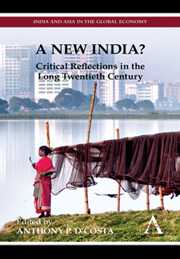Book contents
- Frontmatter
- Contents
- List of Tables and Figures
- Foreword by Deepak Nayyar
- Preface and Acknowledgements
- Chapter 1 What is this ‘New’ India? An Introduction
- Chapter 2 New Interpretations of India's Economic Growth in the Twentieth Century
- Chapter 3 Continuity and Change: Notes on Agriculture in ‘New India’
- Chapter 4 An Uneasy Coexistence: The New and the Old in Indian Industry and Services
- Chapter 5 Is the New India Bypassing Women? Gendered Implications of India's Growth
- Chapter 6 The ‘New’ Non-Residents of India: A Short History of the NRI
- Chapter 7 Revivalism, Modernism and Internationalism: Finding the Old in the New India
- Chapter 8 Creative Tensions: Contemporary Fine Art in the ‘New’ India
- List of Contributors
- Index
Chapter 1 - What is this ‘New’ India? An Introduction
Published online by Cambridge University Press: 05 March 2012
- Frontmatter
- Contents
- List of Tables and Figures
- Foreword by Deepak Nayyar
- Preface and Acknowledgements
- Chapter 1 What is this ‘New’ India? An Introduction
- Chapter 2 New Interpretations of India's Economic Growth in the Twentieth Century
- Chapter 3 Continuity and Change: Notes on Agriculture in ‘New India’
- Chapter 4 An Uneasy Coexistence: The New and the Old in Indian Industry and Services
- Chapter 5 Is the New India Bypassing Women? Gendered Implications of India's Growth
- Chapter 6 The ‘New’ Non-Residents of India: A Short History of the NRI
- Chapter 7 Revivalism, Modernism and Internationalism: Finding the Old in the New India
- Chapter 8 Creative Tensions: Contemporary Fine Art in the ‘New’ India
- List of Contributors
- Index
Summary
Nayi Indian, Nayi Deluxe Bike
(‘New Indian, New Bike’, a fading advertisement on a brick wall in Bansberia, West Bengal, December 2009)Introduction
The labels ‘new India’ and ‘new Indian’ are now commonplace. Businesses hawking products or journalists and social commentators reporting on contemporary India use the label lavishly. There is a new India, which is different from what it was before, an unstated ‘old India’. Presumably there is also a new Indian, who is assumed to enjoy the fruits of a modern, industrial, dynamic India, neither bound by the past nor by provincial thinking. India and Indians are now modern and global. A street advertisement in the up-andcoming Salt Lake residential area outside Kolkata shows high–rise apartment buildings and makes no bones about exhorting passers-by to ‘live like the world does’, an oblique reference to the nouveau riche, whose financial standing is seen as no different from that of the citizens of affluent countries.
What reads like a caricature has been repeatedly reported by the popular and business press, nationally and internationally. The New York Times has made liberal use of the prefix ‘new’ to describe India, as in ‘the high life of young, exuberant New India’ (Sengupta 2008). The new India refers to the country's stirring middle class, its new-found wealth, changing consumption patterns that mimic Western lifestyles, and India's technological sophistication (Simmons and Kahn 2009a, 2009b).
- Type
- Chapter
- Information
- A New India?Critical Reflections in the Long Twentieth Century, pp. 1 - 22Publisher: Anthem PressPrint publication year: 2010
- 1
- Cited by



